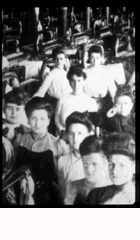
Hard Work “To Make Both Ends Meet”: Maine Women’s Voices, 1888 2004
Distributed by Folkfilms, Jim Sharkey, 193 Main St., Orono, ME 04473; 207-866-7762
Produced by Jim Sharkey
Directed by Jim Sharkey
DVD, color and b&, 59 min.
Sr. High - Adult
History, Women's Studies, American Studies
Date Entered: 06/07/2005
Reviewed by Michelle Zafron, Health Sciences Library, University at Buffalo, State University of New YorkA government agency report hardly sounds like the subject of a scintillating documentary and yet Hard Work “To Make Both Ends Meet”: Maine Women’s Voices, 1888 is just that. In 1888, the Maine State Bureau of Industrial and Labor Statistics conducted a survey of women in the state’s workforce. An open-ended question allowed women to respond with their suggestions on how their working conditions could be improved. Hard Work presents their answers as well as providing an engrossing picture of Maine’s 19th century industrial climate.
The film is organized loosely into sections covering various aspects of working life including living arrangements, wage structure, child labor, immigrants, and working conditions. The original comments are accompanied by still photographs from the time period. A Maine historian provides an overview of the factors that gave rise to the influx of women into the workforce as well as giving viewers a clearer contextual picture of each of the facets addressed. She also recounts the results of the report.
The real power of the documentary comes from the responses of the women in question. Their answers are often thoughtful, articulate, surprisingly astute, and sometimes even applicable to modern working life. Some of the issues that concerned the workers might have come from a contemporary worker; women were worried about water quality, workplace safety, health and fire hazards, salary inequity, and even immigration controls. The historian explains early on that the report was a document of tremendous richness of details and it is easy to see why. Hard Work brings to life opinions and attitudes that are all too often grossly simplified.
If there is a fault with Hard Work, it is the sometimes overly long photographic montages accompanied by musical pieces. However, the documentary's superior content compensates for this comparatively minor issue. It could be used with a wide range of audiences and for a variety of subjects. Hard Work is highly recommended.